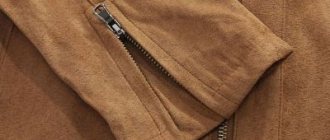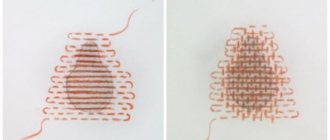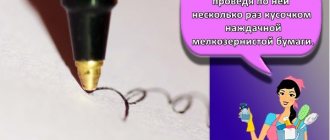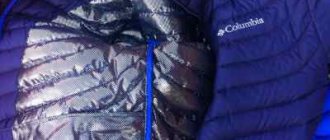For more than a century and a half, jeans have not gone out of fashion. Tastes change, preferences and models change, but the basics remain the same. The clothes are simple and versatile; moreover, they are so comfortable that they become a “second skin” for the wearer.
And how frustrating it is for the owner to see scuffs and tears in his favorite pants. It's a shame to throw it away, but it's inconvenient to wear.
Types and features of patches
There are many options that can give jeans a second life. To do this you just need to install a patch. This method is not only practical, but can be used to give trousers an exclusive look.
You just need to update the product with decorative patches, and uniqueness is guaranteed.
Hand sewn patches
You can repair or decorate your favorite clothes without using a sewing machine. The process is quite simple and does not require special skills or education.
For repairs you will need pieces of fabric, leather, even lace with an adhesive base. They are sewn on from the top, from the wrong side, and represent decorative embroidery or sewing.
To make a regular patch, you need:
- Buy a set of patches to suit your taste at a craft store. When working independently, you will first have to prepare a template from paper. Using it, cut out the workpiece you like, which will cover the repair area with allowances for processing;
- if the fabric is placed on top, then it is better to finish the edges with a decorative seam or make a small fringe;
- secure with pins, baste and iron with a hot iron;
- Use small stitches to secure the patch to the jeans, then wash and dry the product.
By typewriter
If you have a miracle assistant, this will greatly facilitate the task of repairing pants. The patches are easily sewn to the front side using a regular stitch or a zigzag stitch.
The sewing technology is reminiscent of manual work. When making a functional patch, it is best to use a sewing machine - this way the product will last much longer.
Ways to avoid scuffs
In order not to bother with patches and repairs of your favorite jeans, you should follow some wearing and washing rules.
Keep in mind that when buying jeans that are too tight for you, or, conversely, are too loose, be prepared that in the future this will lead to holes that will have to be sealed. Low-waist styles also tend to fray on the inner thigh. In order to avoid troubles, you should buy jeans strictly according to your size, without making allowances for the fact that the fabric will stretch during wear and the jeans will fit more comfortably. As practice shows, not every jeans stretches to the desired size. Well, just in case, inspect the jeans for manufacturing defects.
Materials for patching
Specialized stores offer beautiful and original blanks of various shapes, sizes and shades, fabrics and leather. If it is necessary to repair the product as discreetly as possible, then pieces of original fabric are sewn on.
The material is taken from the leftovers after cutting long legs or cut out under the pockets, replacing it with fabric of a similar color and density.
To mask abrasions and extend the life of denim, adhesive material is used. The part is glued like this:
- cut out a piece of fabric covering the problem area;
- put an adhesive pad and a new patch on the wrong side of the jeans, iron them with a hot iron;
- To add strength, the part to be repaired can be stitched.
Torn pants have not gone out of fashion for several years. Such models are decorated with a variety of patches.
Old clothes will look feminine and attractive if you attach lace or guipure fabric to the inside. The material should match the color of the main fabric.
You can decorate women's or children's pants with satin stitch embroidery. These can be floral ornaments, flags, figures of animals or birds.
Cartoon characters are a great design option for little children. The main thing is that the decor looks harmonious and emphasizes the image of the owner.
What you need for work
For hand sewing you need the following materials and tools:
Seamstresses advise working with household needles, which are sold in a set. To sew up a hole without a sewing machine, use numbers 11 and 14. The threads are also chosen thicker.
Cotton threads from 50 to 80 numbers or from 50 to 60 numbers (synthetics) are suitable. You can also use a sewing machine to repair a hole in your pants.
How to patch a hole in jeans
Depending on where exactly the hole is located, the methods of applying patches will also vary. This must be taken into account.
Repairing a hole in the leg of jeans
Original patches can perform miracles. Not only will they extend the life of your pants, but they can also transform your clothing into a beautiful designer piece.
The main thing is to let your imagination work; the finishing options are very unusual when using factory-made blanks or those made independently.
The easiest way is to apply a backing patch. To do this, you need to cut out a part that is larger in size than the repair area.
Place it with the front part facing the back of the jeans and baste. Seal the gap with a zigzag stitch using threads of a similar shade. Fold the edges of the hole to the wrong side and stitch.
A stylish solution for repairing trousers is to use the Japanese Boro technique. Its essence lies in the use of a large number of identical, parallel stitches.
The fabric used in the work is linen or cotton. Light denim is also welcome. The size of the shred can be any, but the processing allowance is 30-40 mm. What should be done:
- sew the outline of the hole with the stitch forward with the needle. This action is necessary so that the hole does not stretch when wearing pants;
- draw future hand sewing stripes parallel to the edge of the hole. The distance between them is 6-8 mm;
- Apply smooth stitches along the lines. On the reverse side their length is shorter than on the front surface;
- turning to a new row is done on the wrong side;
- The decorative patch is decorated with threads of different colors and stitches of different lengths.
Patch between legs
Scuffs and tears can form in the most inappropriate places in jeans, namely between the legs.
The repair is complex, but the master is able to fix the defect in such a way that nothing is noticeable at first glance. You cannot simply tighten such a hole with threads, since the product will be severely distorted.
To work, you will need a small piece of material, close in shade to the original. First you need to give the hole a neat look by cutting off all the shaggy threads along the edge:
- The sides must be basted to each other to prevent the hole from enlarging. With this approach, the stitches are frequent, wide and not tight. There should be no creases or rough seams in the torn area.
- Next, you need to make a patch template that is as close as possible to the shape of the defect, taking into account processing allowances of 5-8 mm. Cut out the part and pin the flap on the wrong side with bobby pins, preventing it from moving when stitching.
- Having selected sewing threads that are similar in shade, sew a zigzag stitch on the front side of the product along the gap using a machine stitch. This process is called gizmo.
- The lines are laid together at a very close distance. You can use the reverse mode, this will speed up the work.
Repairing a hole in the knee
This is perhaps the most common type of wear and damage to trousers.
A patch on trousers in the knee area, even if it is visible, looks quite neat, beautiful and stylish if it is done by masters of their craft.
Depending on the client’s age and wishes, the shade, shape and design of the patch are selected.
Children's pants can be finished in bright, contrasting tones, while pants for adults can be finished in calm, unremarkable shades. There are several options for repairing holes in knees.
The details of the canvas are applied from the front side, the back side, and an adhesive base is also useful. If the patching is carried out from the outside of the product, then you can make a fringe, decorate the edges with a beautiful seam, or simply tuck and stitch.
The patch in the form of a pocket with a button looks very cute.
Any repair of trousers at the knees will definitely be visible, so jeans are repaired in such a way that the item takes on an original, beautiful look.
To do this you will need a piece of denim of a different color. For example, patches made of purple or blue fabric will look interesting on black jeans. The algorithm of actions looks like this:
- Prepare a suitable template for repairing the product.
- Cut the workpiece, leaving a processing allowance of 5 mm.
- Lay the patch on the trouser leg, secure with pins, and baste.
- Sew it on using a sewing machine or by hand.
- Decorate the other half of the trousers in a similar way, since in this form the item looks more aesthetically pleasing and complete.
Nice patch
Special decorative patches can be seen on a large number of jeans. They give the model a unique image and bring a fresh stream to the development of fashion trends.
To make patches, fabric of various textures is used. They are sewn only on the outside of the trousers. For decorative patches use:
- denim in contrasting colors;
- leather - natural or artificial;
- suede, velvet, lace, guipure;
- factory blanks with satin stitch embroidery or bright seams;
- thermal decals.
Finished or cut parts are applied to the defect, fixed with tailor's pins or basted. Next, they are stitched or sewn manually from the front side.
Thermal patches are applied to the worn area and heated with a hot iron through a damp cloth until dry.
To give greater strength, it is advisable to strengthen the thermal appliqué with a hand or machine seam.
A product transformed by one’s own hand will be a one and only copy and will delight its owner for a long time.
It will take very little time and effort for an old and convenient thing to find a new existence. Experimenting with updates based on a template or your own creative ideas will allow you to create a unique image.
Invisible seam No. 3 – “Hemming”
It is not difficult to guess from the name what this seam is intended for. It is used if you need to reduce the length of trousers or sleeves manually. In this case, the excess fabric is not trimmed, but tucked under. You can also sew a drawstring using this method and insert an elastic band into it. For example, to narrow a dress at the waist.
An invisible hem stitch looks like this:
The difference with the classic filing method is obvious:
How to hem trouser legs step by step:
- Measure the desired length of the trousers. We celebrate with soap.
- Fold the excess fabric to the wrong side 1-2 times. Secure with pins.
- Take a thread that matches the color of your trousers, insert it into a needle, and tie a knot at the end.
- Place the needle under the folded fabric. Inside it we make a stitch of 0.7 cm and bring it out through the edge of the fold.
- We pick up 1-3 threads on the fabric to which we sew the hem.
- We insert the needle into the fold in the place where the thread came out. Make a stitch of 0.7 cm.
- We pick up 1-3 threads on the fabric under the hem and return the needle to the edge of the fold. Making a stitch.
- We continue to sew in the same way. To prevent the fabric from wrinkling, do not pull the thread too tightly.
Video instruction:
What to do if your pants rub between your legs?
So, having understood the causes of abrasions between the legs and how to eliminate them, it is also necessary to mention how to avoid them. A few simple recommendations will help with this.
Always choose clothing that fits properly. Don't expect the trousers to stretch or shrink over time after several washes. Tight pants may not be able to withstand tension and wear out quickly, and pants that are a size larger will constantly rub against each other between the legs, which will also lead to early wear.
What to do to avoid or reduce this effect:
- Choose more wear-resistant materials for trousers;
- Order more than one pair of trousers for one suit;
- Wear boxers underwear;
- Choose trousers with a looser fit;
- Give your trousers a rest, wear them no more than once every two days;
- Choose trousers with a lei.
Another reason is the peculiarity of gait. If the volume of the hips is small, but the legs still rub against each other when walking, then the crotch seam of the trousers will wear out quite quickly and the trousers will have to be repaired. To avoid rubbing, you must constantly monitor your gait. Over time, this will become a habit and will no longer cause discomfort.
If you have a sedentary job or lifestyle, try to fidget less in your chair. To change your body position, rise slightly from your chair. This will help reduce the intensity of friction.
When choosing jeans, try not to buy low-waisted models. As a rule, when worn on such models, folds form between the legs, which can lead to unnecessary holes. Buy jeans with a normal or slightly high rise.
Don't wash your pants too often, as this will significantly shorten their lifespan. When washing, try to use as little household chemicals as possible (rinse aids, stain removers, conditioners). It would be preferable to wash by hand, treating stains with laundry soap and water. You can also use the delicate cycle in your washing machine.
Watch the thickness of the fabric on your pants between your legs. If it has become too thin, then wiping will soon be inevitable. In this case, you can strengthen the weak areas yourself with the help of linings or contact a studio for this task. In any case, it’s better than putting a patch on worn-out pants later.
You shouldn't wear the same pants all the time. Buy two or three pairs and change your jeans every few days. Then the problem of rubbing will bother you much less often.
It is necessary to understand that any hole or abrasion can be eliminated on your own. If your pants are completely worn out, it may be time to buy a new pair and turn your old pants into shorts or use them during car repairs or construction work.
You learned how to avoid rubbing your pants between your legs and discreetly patch them if they are torn. If the information was useful to you, then share it with your friends on social networks.
Option 4
Another option for a denim “highlight” is a flower, which can be used to discreetly and creatively disguise a small hole, for example, in a pocket.
To work, you will need four toothpicks, a bead and threads of any color. You can use, for example, floss or knitting yarn.
Push the toothpicks through the fabric (two along, two across) so that the hole is in the middle. Insert the thread and needle directly into the hole and pull it out of the fabric in the lower left corner. Remove the thread from the needle because the needle will not be needed for the next step.
Now let's start forming the flower. The protruding ends of the toothpicks are the parts around which we will alternately wrap the thread.
First, loop the thread around the bottom left end. From there, start bringing the thread up and wrap it around the top right end. You now have two petals in the shape of a figure eight. So continue to work with the thread (lower left - upper right) until you are satisfied with the thickness of the petals. After this, place the thread at the bottom not at the bottom left, but at the adjacent (to the left of it) end of the toothpick. From there, guide the thread to the empty end of the toothpick opposite. Make enough figure eights again to create voluminous petals. And again move the working thread one toothpick to the left. Continue this way until you have thread wrapped around all the toothpicks.
Now you need to make the middle of the flower. To do this, thread the needle again. Insert it into the center of the flower and bring it out at the top between the toothpicks. Thread the bead onto the thread and secure it right in the middle of the flower. All you have to do is carefully remove the toothpicks from the fabric.
Preparatory stage
You can change the appearance of your trousers very simply; you will only need the usual means at hand. Take your old and worn pants and follow a few simple steps.
Trying on, choosing and designating the location for the hole
First of all, you should try on old things. This way, you can evaluate exactly how the pants will look after the transformation. Think in advance about what specific result you want to achieve. Much depends on the quality of the material, which reacts differently to cuts and damage.
The hole can become deformed and grow. When trying on, make sure where the cuts will be located. Consider not only the characteristics of your anthropometric data, but also the density of the material itself. Mark the area of future holes using white chalk, as it is clearly visible against any background.
Preparing the necessary tools and materials
There are several ways to make a cut on jeans. To do this, you must take the following available items:
- Large and manicure scissors.
- A brush.
- Sandpaper.
- Needle and tweezers.
- Stationery knife (alternative - blade).
- Material that can be placed under a trouser leg.
Why do my pants rub between my legs?
Before you begin the repair, it is worth considering the reasons why your pants rub between your legs. There may be several of them:
- Features of the figure. The main reason for rubbing is the increased volume of the hips. As a result, excess tension in the fabric is created, which reduces the service life of the trousers. Also, due to enlarged hips, the legs come into contact with each other more often when walking, which leads to unnecessary friction of the material.
- Gait. This mainly applies to people who like to waddle. Such a habit increases the load on the crotch seam of the pants, as a result of which the seam wears out and breaks quite quickly.
- Quality of material. Everything is simple here: the stronger the material, the longer the pants made from it last. Corduroy pants are considered the most durable. If we are talking about jeans, then denim with the addition of elastane and polyester is ideal. Linen trousers wear out very quickly and are almost impossible to repair - the material is too delicate.
- Passive lifestyle. This reason is relevant for those who spend a considerable part of their time in a sitting position (for example, working at a computer in the office). Sitting still in a chair for a long time is quite difficult, and frequent fidgeting is what leads to wear and tear on the fabric (hence the expression “wipe your pants in the office”).
- Incorrect care. The wear resistance of the material decreases noticeably if washed incorrectly. After purchasing trousers, it is advisable to read the information on the tag and follow the recommendations shown on it.











